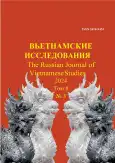The Reforms of the Ruler of Dai Viet Trinh Cuong and Their Negative Consequences
- 作者: Fedorin A.L.1
-
隶属关系:
- Chinese Culture Research Center, Institute of China and Contemporary Asia, RAS
- 期: 卷 8, 编号 3 (2024)
- 页面: 45-56
- 栏目: Scientific researches
- URL: https://bakhtiniada.ru/2618-9453/article/view/266406
- DOI: https://doi.org/10.54631/VS.2024.83-636572
- ID: 266406
如何引用文章
全文:
详细
Chua Trinh Cuong, the de facto ruler of Northern Vietnam at the beginning of the 18th century, is considered in historiography to be an active reformer who sought to establish order in Vietnamese society, achieve its stability and sustainable development. All the blame for the subsequent brutal civil wars is usually placed on his successor, Chua Trinh Giang (ruled 1730–1740), who departed from his father's line and stopped dealing with socio-economic issues. The article, based on primary sources, contains a substantive analysis of the reforms carried out by Chinh Cuong, and proves that in essence they became one of the reasons for the large-scale and long-term social crisis in the country in the middle of the 18th century, which almost led to the fall of the Trinh regime.
作者简介
Andrey Fedorin
Chinese Culture Research Center, Institute of China and Contemporary Asia, RAS
编辑信件的主要联系方式.
Email: ffeedd@list.ru
ORCID iD: 0000-0003-0336-0055
D.Sc. (History), Leading Researcher
俄罗斯联邦参考
- Chúa Trịnh Cương. Cuộc đời và sự nghiệp. Kỳ yếu hội thảo khoa học [Lord Trinh Cuong. Life and career. Proceedings of scientific conference] (2010). Hà Nội: Nxb. Văn hóa thông tin. 605 tr. (In Vietnamese)
- Fedorin, A.L. (2006). Osobennosti v'etnamskoj epigrafiki. Periodizaciya istorii V'etnama XV–XVIII vv. na osnovanii dannyh epigrafiki [Features of Vietnamese epigraphy. Periodization of the history of Vietnam in the 15th -18th centuries. based on epigraphy data], in: Teoriya i metody issledovaniya vostochnoj epigrafiki [Theory and methods of research of eastern epigraphy]. M: Vostochnaya literatura. S. 266–310. (In Russian)
- Fedorin, A.L. (2023). «Golden Age» of Traditional Vietnamese Society. «Continuous Taxation» in the Second Half of the 17th – Beginning of the 18th Century. The Russian Journal of Vietnamese Studies, 7 (4): 50–60. DOI: https://doi.org/10.54631/VS.2023.74-624973. (In Russian)
- Fedorin, A.L. (2024) Voennyie reformy v Severnom Vietname v XVII–XVIII vv. i ih vliyaniye na boyesposobnost armii [Reforms in North Vietnam in the 17th–18th Centuries and their Impact on the Combat Capability of the Army]. Vostok (Oriens), 2: 69–77. DOI: https://doi.org/10.31857/S086919080029999-5. (In Russian)
- Ngô Cao Lãng. Lịch triều tạp kỷ [Ngo Cao Lang. Various records of past dynasties] (1995). Ha Noi: Nxb. Khoa hoc Xa hoi. 695 tr. (In Vietnamese)
- Novaya istoriya Vietnama (1980) [A new history of Vietnam]. M.: Nauka. 719 c. (In Russian)
- Polnoe sobranie istoricheskih zapisok Dajvieta (Dajviet shy ki toan thy): v 8 t. Ruk. proekta D.V. Deopik. [Complete Annals of Dai Viet (Dai Viet su ki toan thu): in 8 volumes. Project director D.V. Deopik] (2002–2022). M.: Vostochnaya literatura (In Russian)
- Ryabinin, A.L. (2022). Postoyannoe oblozhenie v Severnom Vietname (Dangngoae) vo vtoroj polovine XVII - nachale XVIII vv. i Britanskoj Indii v XIX v.: obshchee i osobennoe [Constant taxation in Northern Vietnam (Dang Ngoai) in the second half of the 17th - early 18th centuries and British India in the 19th century: general and special]. Oriental Courier, 4: 141–167. DOI: https://doi.org/10.18254/S268684310023806-4. (In Russian)
补充文件







